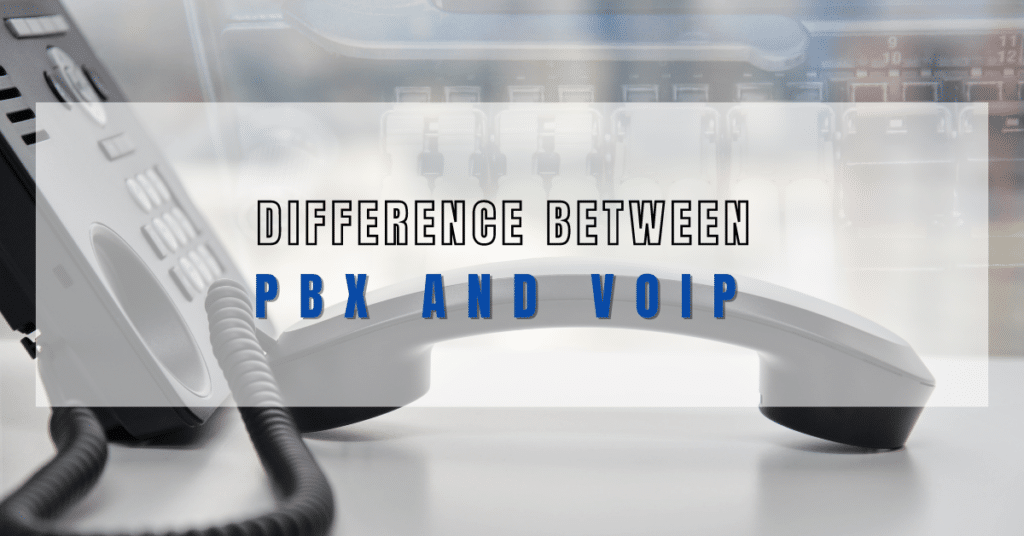Professionally speaking, the difference between PBX and VoIP lies in their functionality and technology. PBX, or Private Branch Exchange, is a private telephone network used within a company or organization.
The users of the PBX phone system can communicate within their company and with the outside world, using different communication channels like Voice over IP and analog.
On the other hand, VoIP, or Voice over Internet Protocol, is a technology that allows you to make voice calls using a broadband Internet connection instead of a regular phone line.
While both can be beneficial for businesses, the choice between PBX and VoIP often depends on the business’s specific needs, including factors like cost, flexibility, and scalability.
A PBX system relies on traditional telephony hardware and installation processes, often resulting in higher setup costs.
On the other hand, VoIP leverages internet connectivity to facilitate calls, offering a cost-effective alternative.
This post will delve into the intricacies of these technology platforms and services to help you discern which might serve your company best.
Key Features of PBX and VoIP Systems
Let’s dive into the world of PBX and VoIP. We’ll examine their unique features, focusing on call routing capabilities, internet-based communication, and scalability options.
Call Routing Capabilities in PBX
PBX phone systems are all about routing calls. They’re like a traffic cop for voice calls.
-
They decide where each call goes
-
If you’re busy, they send the call to voicemail
In short, a PBX system is your operator!
Internet-Based Communication in VoIP
VoIP phone systems work differently. Instead of using traditional telephone lines, they use the Internet.
-
You make a call
-
The VoIP system turns your voice into data packets
-
These packets travel over the Internet to the other person’s device
The cool part? It doesn’t matter if that device is a computer or another VoIP phone!
Scalability Options for Both Systems
Both PBX and VoIP have scalability options. This means that whether your business is small, medium, or large, you can adjust the size of your phone system with both PBX and VoIP to fit your needs.
The Pros and Cons of PBX
PBX Reliability and Stability
PBX systems are known for their reliability. They offer consistent call quality, which is a significant pro for businesses.
-
Stable connection even during power outages
-
High-quality calls with no lags or drops
However, there’s a flip side.
High Setup Costs of PBX
Setting up a traditional PBX can be pricey. It involves the installation process, hardware, and phone models.
-
Costs can rise depending on the complexity of the system
-
Maintenance and updates may require additional expenses
Limitations in Mobility
Traditional PBX systems have some mobility limitations. This could be a con for businesses requiring flexibility.
If your business needs to adapt and change quickly, traditional PBX systems might not be the best choice because they can’t quickly move or change with you.
Advantages and Disadvantages of VoIP
VoIP systems have made a big splash in the business world. Let’s dive into their pros and cons.
Cost-Effective, Flexible VoIP Systems
VoIP systems are a game-changer for businesses. They’re cost-effective and flexible.
-
There is no need to shell out big bucks on traditional phone systems
-
You can make calls from anywhere with an internet connection
-
Features like call recording come as part of the package, with no extra pricing
But it isn’t all sunshine and rainbows.
Internet Dependency Affects Voice Quality
The quality of your calls depends on your internet connection. If your office has a dodgy internet connection, you might experience poor voice quality.
-
Bad weather? Your call quality could take a hit
-
Heavy network traffic? Expect interruptions during calls
It’s not just about call quality, though.
Security Vulnerabilities in VoIP Systems
Like everything online, VoIP systems can be vulnerable to attacks. Hackers could potentially eavesdrop on your calls or disrupt your service entirely.
-
Cyberattacks on VoIP systems are becoming more common
So there you have it. VoIP systems offer flexibility and cost savings but have potential disadvantages around reliability and security.
Businesses must consider these pros and cons before switching from traditional PBX phone solutions.
As VoIP systems can be vulnerable to various forms of cyberattacks, it is crucial to implement measures to prevent and protect the system.
These measures range from simple steps like creating strong, unique passwords for all users to more complex solutions like encryption and network security.
So, working with your VoIP provider to ensure these measures are regularly updated is essential. Your provider should be able to assist with implementing these security measures and provide advice on any additional steps that may be necessary to protect your system.
Regular audits of your VoIP system can also help identify potential vulnerabilities and ensure that all security measures are functioning as intended.
Cost Analysis: PBX vs VoIP
Setup Costs for PBX and VoIP
Setting up a traditional Private Branch Exchange (PBX) can be costly. It involves buying hardware, installing phone lines, and sometimes even renovating your office space to accommodate the new system.
Conversely, Voice over Internet Protocol (VoIP) is generally cheaper to set up. All you need is a reliable internet connection, and you’re good to go.
-
PBX setup cost: High
-
VoIP setup cost: Low
Ongoing Maintenance Expenses
Maintaining a PBX system can also be expensive. Regular check-ups are needed to keep things running smoothly.
VoIP systems require less upkeep. As long as your internet connection is stable, there’s not much else to worry about.
-
PBX maintenance Services cost: High
-
VoIP maintenance cost: Low
Cost-Efficiency for Different Business Sizes
Small Business Telephone Systems
Small businesses often operate on tight budgets. So, the cost-efficiency of a telephone system is crucial. They need a system that’s easy to install, doesn’t require a large team to manage, and offers long-term value.
Here are a few options:
-
VoIP Systems: These are cost-effective and easy to set up. There is no need for a big team or complicated installation process. The downside? It would be best to have a strong internet connection to ensure call quality.
-
PBX Systems: These offer more features but come with higher upfront costs. You’ll need a team for installation and maintenance.
-
Both can provide value in the long term through advanced features like call routing and auto-attendant.
Medium Business Telephone Systems
Medium-sized businesses often have more resources. They can afford a more complex telephone system and have a bigger team to manage it.
Consider these options:
-
Cloud-Based Systems: These systems offer scalability and flexibility. They’re more expensive upfront but can save money in the long term. Plus, they’re easy to manage and don’t require a large team.
-
On-Premise PBX Systems: These systems offer robust features and control. They require a larger team for installation and management. However, they can provide long-term value through advanced features and customization.
Large Business Telephone Systems
Large businesses often have the resources for a high-end telephone system. They have large teams to manage the system and can afford the installation process.
Here are a couple of options:
-
Enterprise VoIP Systems: These systems offer advanced features, scalability, and integration with other business tools. They’re expensive but can provide long-term value.
-
Hybrid Systems: These systems combine the features of VoIP and PBX systems. They’re costly and require a large team for installation and management. However, they offer the best of both worlds, making them a valuable long-term investment.
So, what’s the bottom line? The correct telephone system for your business depends on your business size, resources, and long-term goals.
Consider the installation process, the size of your team, and the features you need. Remember, the cheapest option isn’t always the best. Sometimes, paying more upfront can save you a lot of hassle (and money).
Misconceptions and Trends in PBX and VoIP
Debunking Myths About Poor Voice Quality in VoIP Systems
VoIP systems have come a long way. The myth that all VoIP systems offer poor voice quality is outdated.
-
Modern VoIP services provide excellent sound quality, even better than traditional phone lines.
-
Factors like internet speed and hardware can affect the voice quality. So, it’s not always about the VoIP system itself.
Clarifying Misconceptions Around the Inflexibility or Obsolescence of PBX Systems
PBX systems are not dinosaurs. They’re still relevant today.
-
Traditional PBX systems offer robust functionality for outbound calls
-
They’re an alternative to unified communication platforms
-
The premise-based nature of PBX allows users to maintain control over their telephony infrastructure
But let’s be clear. Both VoIP and PBX have their pros and cons.
The Role of PBX and VoIP in Remote Work
Flexibility with VoIP
VoIP technology is a game-changer for remote work. It lets employees make calls online, no matter where they are. This flexibility is a big win for offices with remote teams.
For example, you’re on vacation but must attend an important meeting. With VoIP, you can hop on the call from your laptop or smartphone!
IP-PBX Supports Remote Teams
Modern IP-PBX systems are also stepping up their game. They offer similar flexibility as VoIP, supporting remote work setups effectively.
These systems use Internet technology to manage calls. So, like with VoIP, employees can stay connected regardless of location.
Challenges of Traditional PBX
However, traditional hardware-based PBXs present some challenges for remote work. These systems require site installation and backup power.
You need to set up PBXs at a specific location, and they need constant electricity to work, which can be pretty tricky if you’re working from home or anywhere outside an office.
Key Factors in Evaluating Phone Systems
When checking out your office phone system, consider these points:
-
Call quality: Are calls clear or sound like you’re underwater?
-
Business phone features: Does your system have voicemail or hold music or conference calling?
-
Infrastructure: Can your current setup handle additional phones or lines?
A reputable telephony partner can help you evaluate these factors.
Indicators for Switching from PBX to VoIP
Several indicators may suggest it’s time for a business to switch from a traditional Private Branch Exchange (PBX) phone system to a Voice over Internet Protocol (VoIP) system.
VoIP could offer significant savings if your company is experiencing high call costs, particularly for long-distance or international calls, as it uses the Internet to transmit calls rather than traditional phone lines.
Another indicator is if your business requires more advanced features such as call forwarding, voicemail to email, or video conferencing, often included in VoIP packages.
VoIP is generally easier and cheaper to expand if your business is growing and needs a scalable phone system than PBX.
Lastly, if your current PBX system is aging and requires frequent maintenance or replacement parts, switching to a VoIP system could be more cost-effective, which is often easier and cheaper to maintain.
The Future of PBX and VoIP
As the world continues to evolve technologically, both PBX and VoIP systems play pivotal roles in shaping communication.
Each approach presents unique features, advantages, and disadvantages that businesses must consider when selecting a suitable phone system setup.
These technologies heavily influence the future of business communications, especially with the increasing need for remote work solutions.
The cost analysis between PBX and VoIP systems is crucial for businesses to understand their financial implications. Misconceptions exist around both systems, but understanding current trends can help debunk these myths.
Evaluate your current setup thoroughly, considering all factors discussed in this article.
Remember, choosing the right system could be a game-changer for your organization’s communication needs.
FAQ
What are some key differences between PBX and VoIP?
PBX (Private Branch Exchange) is a private telephone network used within an organization, while VoIP (Voice over Internet Protocol) uses IP technology to make calls via the Internet.
Which system is more cost-effective – PBX or VoIP?
Generally speaking, VoIP tends to be more cost-effective as it utilizes existing internet connections rather than requiring dedicated phone lines like PBX.
How do PBX and VoIP support remote work?
Both systems offer remote work solutions but in different ways. A cloud-based or hosted PBX can enable remote access, while a VoIP system inherently supports remote use due to its reliance on internet connectivity.
What misconceptions exist about both systems?
Some common misconceptions include thinking that the quality of calls on a VoIP system is poor or that maintaining a traditional PBX system will always be expensive.
How do I know which phone system setup is best for my business?
Evaluate your current setup against your business needs, considering cost, remote work capabilities, scalability, and each system’s specific features. That will help highlights the differences between PBX and VoIP and which will server your needs better.



